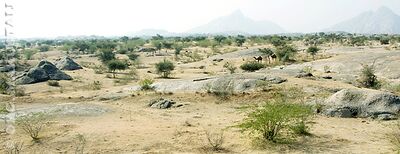Marusthali
Marusthali, ( Sanskrit: मरुस्थली) is a sand-dune-covered eastern portion of the Great Indian Thar Desert in western Rajasthan. It extends over about 24,000 square miles (62,000 square km), north of the Luni River.
The Sanskrit words Marusthali and Marusthal have the same meaning, i.e. the desert. It can also be called Marubhumi (मरुभूमि).
Some western writers have translated the meaning of the word Marusthali, as “Land of the Dead”, which is a wrong interpretation, as they have translated the word Maru (मरु) as dead. This translation is wrong according to Sanskrit grammar.
The Aravalli Range, the area’s most striking feature, defines the Marusthali’s eastern limits. The sand dunes in the region’s northern half are ridges of densely packed, coarse sand. The southern half of the Marusthali forms a vast bowl, rimmed by flat-topped hills of sand, rocks, and limestone. The Luni River, its channels often obliterated by windblown sand, is the major river and forms the southern boundary of the Marusthali. The soils are mostly loamy sands.
मरुभूमि या मरुस्थल
मरुस्थल या 'रेगिस्तान' को भुगोलशास्त्र के अनुसार ऐसी स्थलाकृति के रूप में परिभाषित किया गया है, जहाँ वर्षा, बौछार, हिम, बर्फ आदि रूपों में, बहुत कम लगभग 250 मि.मी. तक होती है। एक और परिभाषा के अनुसार रेगिस्तान या मरुस्थल एक बंजर, शुष्क क्षेत्र है, जहाँ वनस्पति नहीं के बराबर होती है, यहाँ केवल वही पौधे पनप सकते हैं, जिनमें जल संचय करने की अथवा धरती के बहुत नीचे से जल प्राप्त करने की अदभुत क्षमता हो। यहाँ पर उगने वाले पौधे ज़मीन के काफ़ी नीचे तक अपनी जड़ों को विकसित कर लेते हैं, जिस कारण नीचे की नमी को ये आसानी से ग्रहण कर लेते हैं। मिट्टी की पतली चादर, जो वायु के तीव्र वेग से पलटती रहती है और जिसमें कि खाद-मिट्टी प्राय: का अभाव होता है, वह उपजाऊ नहीं होती। इन क्षेत्रों में वाष्पीकरण की क्रिया से वाष्पित जल, वर्षा से प्राप्त कुल जल से अधिक हो जाता है, तथा यहाँ वर्षा बहुत कम और कहीं-कहीं ही हो पाती है। अंटार्कटिका क्षेत्र को छोड़कर अन्य स्थानों पर सूखे की अवधि एक साल या इससे भी अधिक भी हो सकती है। इस क्षेत्र में बेहद शुष्क व गर्म स्थिति किसी भी पैदावार के लिए उपयुक्त नहीं होती है।[1]
References in History
Description of the Desert. — The hand of Nature has defined, in the boldest characters, the limits of the great desert of India, and we only require to follow minutely the line of demarcation ; though, in order to be distinctly understood, we must repeat the analysis of the term Marusthali, the emphatic appellation of this ' region of death.' The word is compounded of the Sanskrit mri, ' to die,' and sthala, ' arid or dry land,' which last, in the corrupted dialect of those countries, becomes thal, the converse of the Greek oasis, denoting tracts particularly sterile. Each thal has its distinct denomination, as the ' thal of Kawa,' the ' thal of Guga,' etc. ; and the cultivated spots, compared with these, either as to number or magnitude, are so scanty, that instead of the ancient Roman simile, which likened Africa to the leopard's hide, reckoning the spots thereon as the oases, I would compare the Indian desert to that of the tiger, of which the long dark stripes would indicate the expansive belts of sand, elevated upon a plain only less sandy, and over whose surface numerous thinly-peopled towns and hamlets are scattered.
Boundaries of the Desert. — Marusthali is bounded on the north by the flat skirting the Ghara ; on the south by that grand salt-marsh, the Ran, and Koliwara ; on the east by the Aravalli ; and on the west by the valley of Sind. The two last boundaries are the most conspicuous, especially the Aravalli, but for which impediment Central India would be submerged in sand; nay, lofty and continuous as is this chain, extending almost from the sea to Delhi, wherever there are passages or depressions, these floating sand-clouds are wafted through or over, and form a little thal even in the bosom of fertility. Whoever has crossed the Banas near Tonk, where the sand for some miles resembles waves of the sea, will comprehend this remark. Its western boundary is alike
[p.1259]: defined, and will recall to the English traveller, who may be destined to journey up the valley of Sind, the words of Napoleon on the Libyan desert : " Nothing so much resembles the sea as the desert ; or a coast, as the valley of the Nile " : for this substitute 'Indus' [291], whence in journeying northward along its banks from Haidarabad to Uchh, the range of vision will be bounded to the east by a bulwark of sand, which, rising often to the height of two hundred feet above the level of the river, leads one to imagine that the chasm, now forming this rich valley, must have originated in a sudden melting of all the glaciers of Caucasus, whose congregated waters made this break in the continuity of Marusthali, which would otherwise be united with the deserts of Arachosia.[2]
External Links
- https://www.britannica.com/place/Marusthali
- http://singhal-rajasthanguide.blogspot.co.nz/2006/12/marusthali-and-ancient-harappan.html
- http://www.indiawaterportal.org/regions/marusthali-thar-desert
Author
| Dayanand Deswal |
